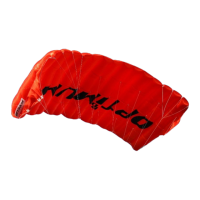MAN-0012 Rev. I Page | 12
MINIMUM DEPLOYMENT ALTITUDES
Though it is best to slow down from a high speed dive before deploying, the overriding factor
must be to deploy above your minimum safe altitude, regardless of your airspeed. For more
information on minimum opening altitudes, consult your country’s national organization that
governs skydiving activities.
You must deploy your main canopy high enough to allow for sufficient altitude for a safe reserve
deployment. When determining a minimum safe altitude you must also consider AAD activation
altitude. You must deploy your main parachute at a sufficiently high altitude that you will be able
to recognize a malfunction on your main parachute and be able to deal with it appropriately before
getting to the AAD activation altitude.
THE EFFECTS OF ALTITUDE ON AIRSPEED
True airspeed (the speed you are actually going) increases by about 2% per thousand
feet of altitude above sea level. At 10,000 feet you will be going about 20% faster than what
the airspeed indicator in the aircraft indicates. This means that your typical sea level freefall
speed of 110kts will actually be about 135kts. At 20,000 feet there is a 40% increase in airspeed.
Therefore a flat and stable body position may be over 150kts.
Though typical jump aircraft are in the 80 kts – 100 kts jump speed range, exit speeds
can be 125kts or more. If the aircraft airspeed indicator is indicating over 125kts at 10 000
feet, you are going faster than the 150kts maximum certified airspeed of most reserves. An
aircraft with an indicated airspeed of greater than 107kts at 20,000 feet will also put you over
150kts true airspeed on exit, which is over the maximum operating speed of most parachutes.
The maximum deployment speed listed on the warning label is based on standard day conditions
at sea level. Deploying your parachute at higher altitudes and temperatures greatly affects the
true airspeed you are actually going whether in an aircraft or in freefall. These effects may make
it relatively easy to exceed the airspeed limitations of most reserves in certain conditions. The
average free fall speed near sea level is approximately 90 - 100 kts, though speeds of
up to 110kts are not uncommon. This higher speed is common with people having less body
surface area, heavier in weight or with smaller, slicker jumpsuits. Even if you do not fit into this
category, it will only take a slight dive to reach 110 kts.
THE EFFECT TEMPERATURE HAS ON AIRSPEED
Additionally, air temperature also affects airspeed. All placard speed limits and the above
examples assume standard day conditions of 59 deg F (15 Deg C) at sea level. Standard
temperature decreases by about 3.5 deg F (2 deg C) per thousand feet. Your true airspeed will
be about 1% higher for each 5 deg F (3 deg C) above the standard temperature at deployment
altitude.
From the above information, you can see that it is very possible to exceed the airspeed
limitation of your reserve, especially at high altitudes and variances in temperatures.
With head down, sit flying, tumbling, or other body positions you can exceed the maximum
speeds of most reserves quite easily.

